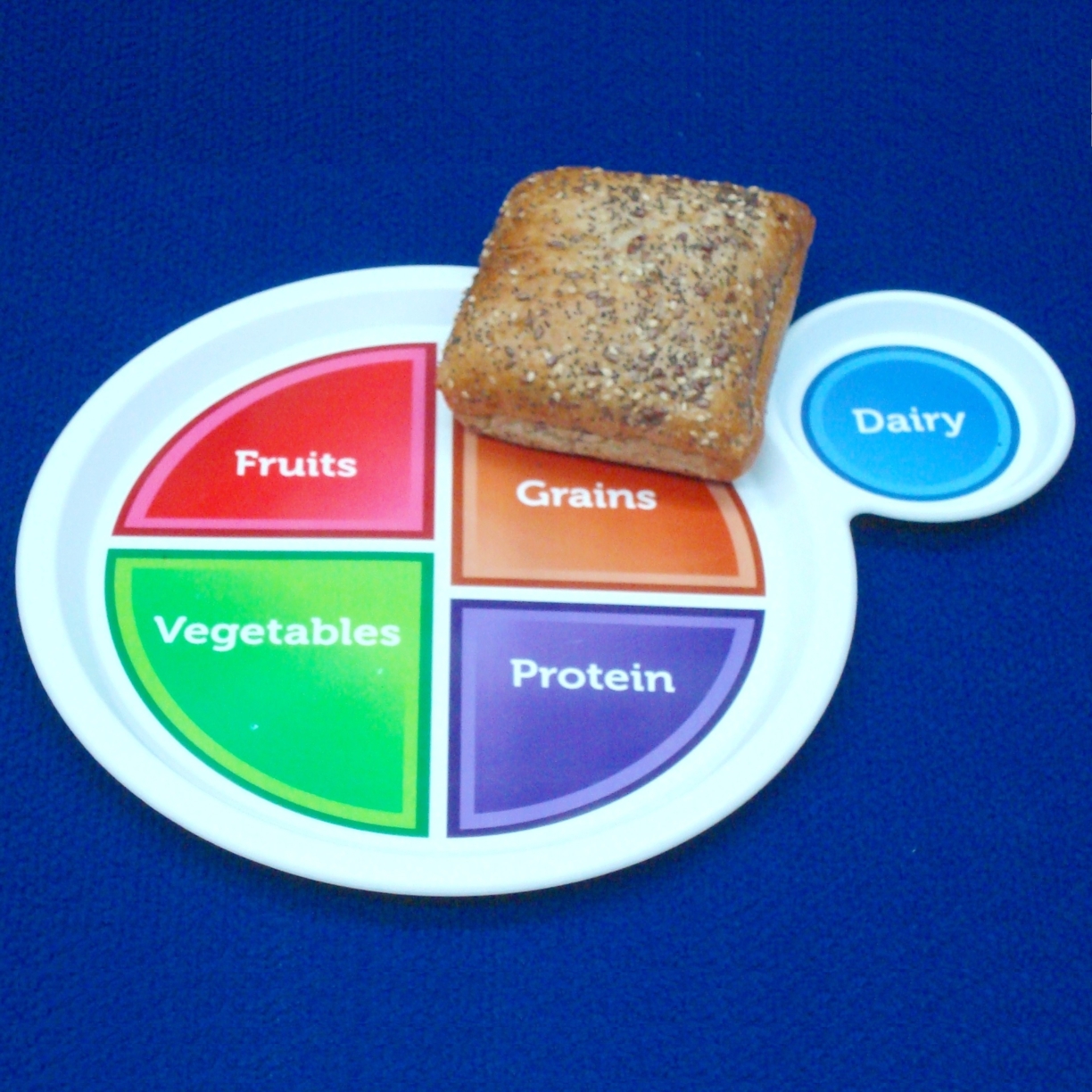
by Angela Hinkle | May 1, 2015
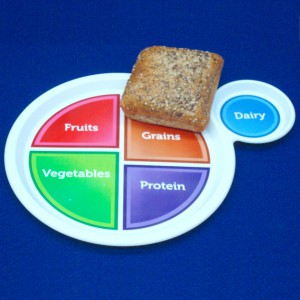
MyPlate “Roll Model”
Set a good example for your family and friends by eating whole grains in meals and snacks. Whole grain rolls, tortillas, hot and cold cereals, breads, pastas, crackers, and brown rice are excellent foods that boast health benefits and add a variety of tastes and textures into your diet.
What is a whole grain?
There are two categories of grains, Whole Grains and Refined Grains. Whole grains include all the parts of the grain kernel – the bran, germ, and endosperm. These different parts add numerous vitamins, minerals, and fiber. Whole-wheat flour, brown rice, and oatmeal are examples of whole grains. Refined grains have been processed to remove the bran and germ, which removes vitamins, minerals, and fiber. White flour and white rice are examples. Most refined grains are enriched so some of the vitamins are added back in after processing.
How do you know if it is a whole grain?
Just because it is brown does not make it whole. Look for the word “whole” to be listed first in the ingredients. Also, look for 100% whole grain. (100% wheat on the front label is usually not the same as 100% whole wheat.) Look for brown rice instead of white.
Why should half your grains be whole grains?
People who eat whole grains as part of a healthy diet have reduced risk of some chronic diseases like heart disease, diabetes, and certain cancers. Consuming fiber-rich whole grains may reduce constipation. Also, eating whole grain foods every day may help with management of weight.
How can your family eat more whole grains?
Try swapping a whole grain like whole-wheat tortillas for refined-flour tortillas. For a little something different, give brown rice or whole-wheat pasta a try or even a whole grain pizza crust. Add whole grains like brown rice or barley to vegetable soups and add bulgur or whole-wheat pasta to casseroles. Whole grain crackers, unsweetened whole grain cereal, or rolled oats add a nice coating to baked meats and vegetables. Whole-wheat bread or cracker crumbs are great in a meatloaf. Make a whole grain cereal snack mix by combining three or four different whole grain cereals. Snack on popcorn – it’s a whole grain (just remember to limit the addition of salt and butter.)
For more information and ways to eat healthy from all the food groups, check out http://www.choosemyplate.gov/food-groups/index.html or contact your local UF/IFAS Extension Office http://directory.ifas.ufl.edu/Dir/searchdir?pageID=3&pl=05
When you eat the “model” whole grain roll (and other whole grain foods), you’re being a good “roll” model for those around you. Try a variety of whole grain foods starting today.

by Monica Brinkley | May 1, 2015
 With summer approaching, you might be asking, “What am I going to do with my children while they are out of school?” One solution is to get them involved in a club. 4-H is the youth organization of the Land Grant University System, of which the UF/ IFAS Extension Service is a part. 4-H and other clubs offer many benefits to youth who participate.
With summer approaching, you might be asking, “What am I going to do with my children while they are out of school?” One solution is to get them involved in a club. 4-H is the youth organization of the Land Grant University System, of which the UF/ IFAS Extension Service is a part. 4-H and other clubs offer many benefits to youth who participate.
For many children, they need to get out and do something. Research has pointed out many negative effects of spending too many hours in front of a television or on the computer. It is much healthier to be actively involved in activities, especially with other people.
I have said many times that idle time was detrimental to my children. Out of school time can be dangerous, as many children are exposed to drugs, alcohol, crime, and the list goes on. Clubs are a constructive way to spend their time.
Clubs offer a wonderful opportunity for children to meet new people and make new friends. Oftentimes, 4-H clubs are centered on a specific project or topic. Therefore, friendships or acquaintances are built around a common interest.
Life skill development is one of the greatest advantages of belonging to a 4-H club. Self-confidence grows as a result of obtained life skills. You can see from the chart below the four life skill areas and how the club leaders address the life skills through club involvement:
| 4-H Life Skill Area |
Targeted Life Skill(s) |
Suggested Activity |
| Head (thinking) |
Critical thinking, problem solving |
Use team-based activities with positive interdependence such as creating a group presentation on livestock disease |
| Head (managing) |
Goal setting, planning/organization, wise use of resources, keeping records, resiliency |
Assign individual roles such as leader, recorder, or materials manager to meet group goals |
| Heart (relating) |
Communications, cooperative, social skills, conflict resolution, accepting differences |
Provide youth with a means to assess group work skills and reflect on student performance independent from the other learning objectives |
| Heart (caring) |
Empathy, sharing, nurturing relationships |
Create long-term groups youth work within to share materials such as textbooks or tools |
| Hands (giving and working) |
Contribution to group, teamwork |
Successes and failures are shared by all members equally. Individual members can be randomly selected for assessment that will reflect on the knowledge/skills of the entire group. |
| Note: 4-H life skill areas and targeted life skills are from Norman and Jordan (2006), available at http://edis.ifas.ufl.edu/4h242. |
Many clubs have a great emphasis on teamwork. Members are encouraged to work toward a common goal. This can be done in a variety of ways including community service, group projects, or during camp, just to name a few. Youth develop independence as they gain these skills to carry throughout life.
Last, but not least, leadership and responsibility can be obtained with club involvement. Youth are allowed to make their own decisions, elect officers, and learn to lead, follow, and carry out their responsibilities.
What better way to learn these skills during their childhood in a safe environment than through club involvement in 4-H or other youth organizations? If your child is not involved in a club, use the summer to see what is offered in your community that will meet your family’s needs.
If you are interested in learning more about 4-H, go to florida4h.org.

by Ricki McWilliams | Apr 14, 2015
 Spring has Sprung
Spring has Sprung
Still trying to get past those winter blues? Get outside, enjoy the Spring weather, and do something active! Regardless of age or fitness level it is important to incorporate physical activity into your daily routine.
Some people might say they cannot be active due to lack of time however, fitting in physical activity can be simple and easy. As little as 10 minutes of activity at a time can provide healthful benefits. Being physically active can limit conditions such as heart disease, type 2 diabetes, high blood pressure, high blood cholesterol, and risk of stroke (Physical Activity, 2015). There are many types of physical activity; aerobic, muscle strengthening, bone strengthening, and balance and stretching.
To make exercise easy, fun and beneficial just mix and match:
- take a 10 minute walk at lunch time
- walk the dog
- garden
- lift weights
- join an exercise group
- practice yoga
- jump rope
- swim
Make being active a family affair. Strengthen family bonds and improve quality of life through a variety of outdoor activities that provide exercise and entertainment. Outdoor family fun activities include but are not limited to: walking, hiking, swimming, running, bicycling, kayaking, canoeing, and tree climbing. The body is able to convert sunshine into vitamins and when physically active the body releases good endorphins improving mood/outlook. Good for the mind and body, outdoor activities can also increase awareness of the environment, as well as, be easy on the budget.
Click here for more tips on how to increase physical activity at home, work and play. Make being active a part of your daily routine.
Still feeling like there are barriers keeping you from being active? Read more here on overcoming common barriers to physical activity.
Resource:
Physical Activity. (2015). http://www.choosemyplate.gov/physical-activity/why.html
by Shelley Swenson | Mar 29, 2015
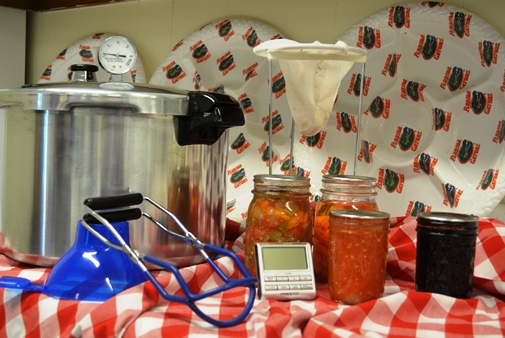
Get your pressure canner ready for the season.
Photo by Les Harrison, Wakulla County
In addition to planting your spring garden and reviewing the latest food safety materials, you should consider having your pressure canner gauge tested. Today’s pressure canner may have a dial gauge for indicating the pressure or a weighted gauge, for indicating and regulating the pressure.
Weighted gauges will either keep rocking gently or make a frequent jiggling noise to indicate that the correct pressure is being maintained. Read the manufacturer’s instructions to know how a particular weighted gauge should rock or jiggle. Weighted gauges do not require testing.
Check dial gauges for accuracy before use each year. Gauges that read high cause under-processing and may result in unsafe food. Low readings cause over-processing. Pressure adjustments can be made if the gauge reads up to 2 pounds high or low. Replace gauges that differ by more than 2 pounds.
Many UF/IFAS Extension Offices have pressure gauge testers and are willing to test yours for accuracy. It is always best to call for an appointment to insure that the FCS Agent is going to be in when you arrive. Don’t remove the gauge but bring the entire lid. If you prefer or if you find that your extension office does not offer this service, Presto will test gauges at no charge. For more information, phone Presto Customer Service: 1-800-877-0441 or contact@gopresto.com.
Handle canner lid gaskets carefully and clean them according to the manufacturer’s directions. Nicked or dried gaskets will allow stem leaks during pressurization of canners. Keep gaskets clean between uses. Gaskets on older model canners may require a light coat of vegetable oil once per year. Gaskets on newer model canners are pre-lubricated and do not benefit from oiling. Check you canner’s instructions if there is doubt that the particular gasket you use has been pre-lubricated.
Lid safety fuses are thin metal inserts or rubber plugs designed to relieve excessive pressure from the canner. Do not pick at or scratch fuses while cleaning. Use only canners that have the Underwriter’s Laboratory (UL) approval to ensure their safety.
Replacement gauges and other parts are often found at stores that sell food preservation equipment or from canner manufacturers. When ordering parts, be sure to provide your canner model number and describe the parts that you need.
Remember, pressure does not destroy microorganisms, but high temperatures applied for an adequate period of time do kill microorganisms. The success of destroying all microorganisms capable of growing in low-acid, canned food is based on the temperature obtained in pure steam, free of air, at sea level. At sea level, a canner operated at a gauge of 10.5 pounds provides an internal temperature of 240o.
For more information, contact your County Extension Family and Consumer Sciences Agent.
by Heidi Copeland | Mar 24, 2015
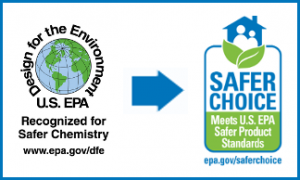
On March 4, 2015 the EPA (Environmental Protection Agency) unveiled a new Safer Choice label/logo, which makes it easier to find household cleaners and other home products that are safer, more environmentally friendly—and still get the job done!
Finding cleaning and other products that are safer for you, your family, and the environment should be easy. Products with the Safer Choice label help consumers and commercial buyers identify and select products with safer chemical ingredients, without sacrificing quality or performance.
Safer Choice labels can be found on laundry products, all-purpose cleaners, car care products, dishwashing products, tub and tile products as well as floor care products. Some of these products will also carry a “Fragrance-free” notation.
The Safer Choice standard, formerly known as DfE’s – Standard for Safer Products (or the “DfE Standard”) identifies that the products and their ingredients met the Safer Choice label/logo requirement.
Safer Choice used the technical expertise of its workgroup (EPA scientists, formulators and even environmentalists to identify ingredients with the lowest hazard profile). While many of us take cleaning products for granted most are a highly scientific formula of ingredients, each with its distinct functional properties. Take dish washing liquid for example. Many of these products contain surfactants that aid in cleaning by reducing surface tension, solvents that dissolve or suspend materials, and chelating agents that reduce water hardness. Without the use of these ingredients we would probably complain about the effectiveness of the product.
A Safer Choice product contains the safest possible ingredients. Each ingredient has been screened for negative synergies (dangerous chemical combinations), potential human health effects, and environmental effects– based on the best available data. Safer Choice products will use ingredients with the lowest hazard in their functional class while still be high-performing.
Only products who have become Safer Choice partners can earn the right to display the Safer Choice product label/logo. Products using the Safer Choice label/logo have invested heavily in research, development and reformulation to ensure that their ingredients and finished product align at the green end of the health and environmental spectrum, while maintaining product performance.
Please note, the use of the Safer Choice label/logo does not constitute endorsement from the Environmental Protection Agency (EPA). It does however, recognize the company using the Safer Choice label/logo has gone through rigorous screening and uses ingredients with more positive human health and environmental characteristics than conventional products of the same type.
For more information see:
http://www2.epa.gov/saferchoice/safer-choice-standard
Heidi Copeland
Extension Agent II
Have a question? Contact the University of Florida IFAS – Leon County Extension office at 606-5203, weekdays 8 a.m. to noon or 1 to 5 p.m.
University of Florida IFAS – An Equal Opportunity Institution
by Heidi Copeland | Mar 24, 2015
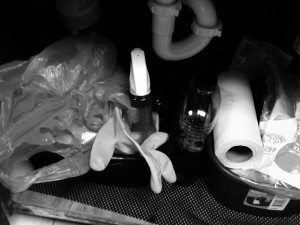
Spring cleaning of one’s home is a tradition dating back centuries that is tied to the vernal equinox – the first day of spring. At the spring equinox, days are approximately 12 hours long with day length increasing as the season progresses. In many cultures this longer, lighter, warmer day is often a cause for celebration! And who could even think about celebrating a longer, lovelier day without a clean home?
The kitchen is a great place to start! You can protect yourself by preventing the spread of germs where food is prepared. However, the terms clean, sanitize and disinfect are often used interchangeably which can cause confusion. Best practices based upon current research state that cleaning and sanitizing is multi-step process. And even though surfaces look visibly clean, they may still be contaminated with microorganisms (infectious fungi, bacteria and viruses).
Cleaning is the removal of dirt from food preparation surfaces. These can be counters, cutting boards, dishes knives, utensils pots and pans – even your refrigerator.
- Wash surface with soap and warm water
- Rinse with clean water
- Air dry or dry with a clean disposable towel
Sanitizing reduces germs on inanimate – nonliving surfaces.
- Wash surface with soap and warm water using appropriate cleaning agents and equipment. Detergents can penetrate soil quickly whereas solvent, acid or abrasive cleaners may be needed for deep cleaning. The friction of cleaning — often with soap and water — removes most surface germs, which is adequate for most household surfaces.
- Rinse with clean water
- Air dry or dry with a clean disposable towel
Disinfecting destroys or inactivates most germs on inanimate surfaces.
- Wash surface with soap and warm water
- Rinse with clean water
- Disinfecting is not appropriate in all cases. However, it’s a good idea to get in the routine of disinfecting countertops, door and cabinet handles, and sink and sink faucets as these places are used frequently- think where dirt and guck can collect!
- Air dry or dry with a clean disposable towel
Also remember to disinfect dishcloths – often. Launder dishcloths frequently using the hot water cycle of the washing machine. Be sure to dry cloths thoroughly. These items can harbor bacteria and when wet, promote bacterial growth. Also, consider using disposable towels to clean up surfaces.
And don’t forget your kitchen sink drain and disposal. Once or twice a week clean, sanitize and disinfect.
Bathroom surfaces can be of critical concern. Surfaces closest to the toilet bowl – seat, cistern and nearby walls and shelving are most affected. When cleaning and disinfecting bathroom surfaces it is important to understand fecal matter is especially a huge matter of concern!
Then there are our general housekeeping surfaces, floors, walls, and furniture, which are low–touch surfaces that require low-level of disinfections. Cleaning these surfaces frequently with a bit of detergent or a low-level disinfectant designed for general housekeeping can decrease the level of contamination. General procedures should be followed. Remove dirt form surfaces (dust, vacuum or sweep) sanitize or disinfect, allow surfaces to air dry.
Thorough cleaning of all surfaces is important to reduce the spread of pathogens. High-touch surfaces, surfaces that are handled frequently, throughout the day, by numerous people, need cleaning and disinfecting. These surfaces can include doorknobs, light switches, phones, keyboards etc. that can become contaminated by objects such an inadequately cleaned rag, sponges or even improperly washed hands.
Cleaning regularly prevents the build-up of materials that can carry pathogens and support their growth. Some pathogens, viruses especially, can have a long shelf life and can stay on surfaces if they are not properly cleaned, sanitized or disinfected.
Take a look at The University of Florida IFAS EDIS publication explaining the use of common household products to use effectively as sanitizers. Also remember, it is critical to read and follow the safety instructions on any product you use.
http://edis.ifas.ufl.edu/pdffiles/FY/FY128000.pdf
http://www2.epa.gov/saferchoice
Heidi Copeland Extension Agent II Family and Consumer Sciences
615 Paul Russell Road Tallahassee, FL 32301-7060 850/606-5203









